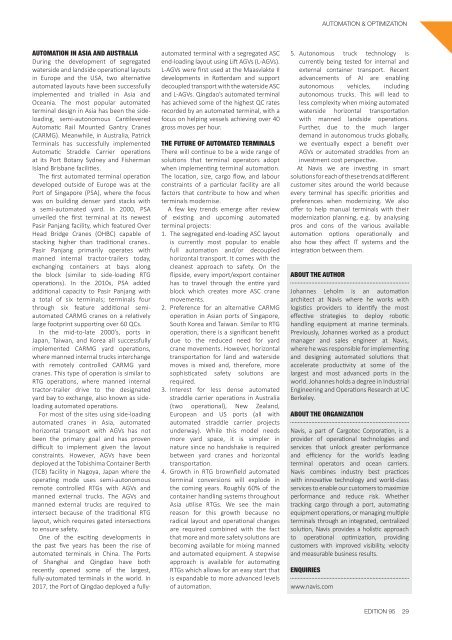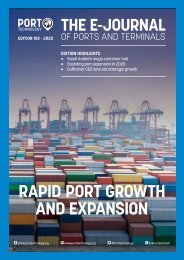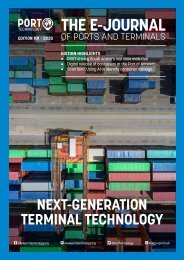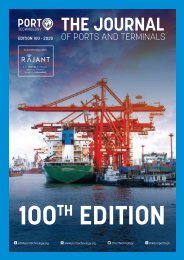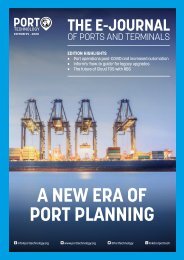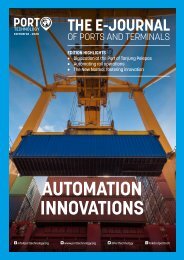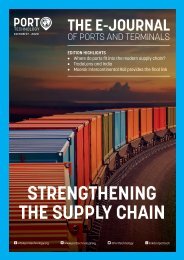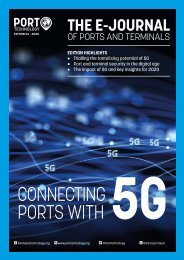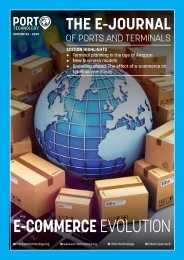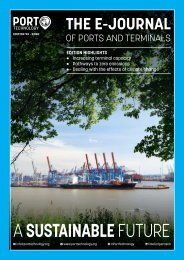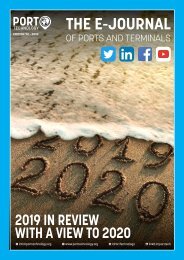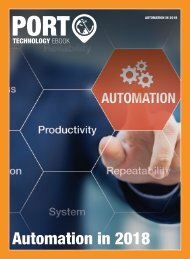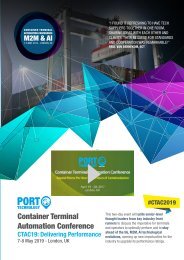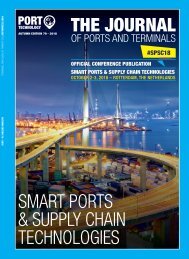Automation's Next Step
This edition of The Journal considers automation of container terminals and how the industry is delivering the next steps towards full and semi-automation. With the inclusion of over 30 technical papers The Journal also explores terminal planning in the age of automation, environmental sustainability for ports, the impact of mega ships and other topics. Automation continues to drive innovation across several industries, and there is no greater example of this than maritime. However, implementation, technology and best practices continue to be a constant source of debate and analysis across the sector, as is shown in this edition of the PTI Journal. The automation debate is not new, but it remains a booming market and a source of growth for the wider container terminal industry. One thing is for certain, automation is here to stay.
This edition of The Journal considers automation of container terminals and how the industry is delivering the next steps towards full and semi-automation.
With the inclusion of over 30 technical papers The Journal also explores terminal planning in the age of automation, environmental sustainability for ports, the impact of mega ships and other topics.
Automation continues to drive innovation across several industries, and there is no greater example of this than maritime.
However, implementation, technology and best practices continue to be a constant source of debate and analysis across the sector, as is shown in this edition of the PTI Journal.
The automation debate is not new, but it remains a booming market and a source of growth for the wider container terminal industry.
One thing is for certain, automation is here to stay.
Create successful ePaper yourself
Turn your PDF publications into a flip-book with our unique Google optimized e-Paper software.
AUTOMATION & OPTIMIZATION<br />
AUTOMATION IN ASIA AND AUSTRALIA<br />
During the development of segregated<br />
waterside and landside operational layouts<br />
in Europe and the USA, two alternative<br />
automated layouts have been successfully<br />
implemented and trialled in Asia and<br />
Oceania. The most popular automated<br />
terminal design in Asia has been the sideloading,<br />
semi-autonomous Cantilevered<br />
Automatic Rail Mounted Gantry Cranes<br />
(CARMG). Meanwhile, in Australia, Patrick<br />
Terminals has successfully implemented<br />
Automatic Straddle Carrier operations<br />
at its Port Botany Sydney and Fisherman<br />
Island Brisbane facilities.<br />
The first automated terminal operation<br />
developed outside of Europe was at the<br />
Port of Singapore (PSA), where the focus<br />
was on building denser yard stacks with<br />
a semi-automated yard. In 2000, PSA<br />
unveiled the first terminal at its newest<br />
Pasir Panjang facility, which featured Over<br />
Head Bridge Cranes (OHBC) capable of<br />
stacking higher than traditional cranes..<br />
Pasir Panjang primarily operates with<br />
manned internal tractor-trailers today,<br />
exchanging containers at bays along<br />
the block (similar to side-loading RTG<br />
operations). In the 2010s, PSA added<br />
additional capacity to Pasir Panjang with<br />
a total of six terminals; terminals four<br />
through six feature additional semiautomated<br />
CARMG cranes on a relatively<br />
large footprint supporting over 60 QCs.<br />
In the mid-to-late 2000’s, ports in<br />
Japan, Taiwan, and Korea all successfully<br />
implemented CARMG yard operations,<br />
where manned internal trucks interchange<br />
with remotely controlled CARMG yard<br />
cranes. This type of operation is similar to<br />
RTG operations, where manned internal<br />
tractor-trailer drive to the designated<br />
yard bay to exchange, also known as sideloading<br />
automated operations.<br />
For most of the sites using side-loading<br />
automated cranes in Asia, automated<br />
horizontal transport with AGVs has not<br />
been the primary goal and has proven<br />
difficult to implement given the layout<br />
constraints. However, AGVs have been<br />
deployed at the Tobishima Container Berth<br />
(TCB) facility in Nagoya, Japan where the<br />
operating mode uses semi-autonomous<br />
remote controlled RTGs with AGVs and<br />
manned external trucks. The AGVs and<br />
manned external trucks are required to<br />
intersect because of the traditional RTG<br />
layout, which requires gated intersections<br />
to ensure safety.<br />
One of the exciting developments in<br />
the past five years has been the rise of<br />
automated terminals in China. The Ports<br />
of Shanghai and Qingdao have both<br />
recently opened some of the largest,<br />
fully-automated terminals in the world. In<br />
2017, the Port of Qingdao deployed a fullyautomated<br />
terminal with a segregated ASC<br />
end-loading layout using Lift AGVs (L-AGVs).<br />
L-AGVs were first used at the Maasvlakte II<br />
developments in Rotterdam and support<br />
decoupled transport with the waterside ASC<br />
and L-AGVs. Qingdao’s automated terminal<br />
has achieved some of the highest QC rates<br />
recorded by an automated terminal, with a<br />
focus on helping vessels achieving over 40<br />
gross moves per hour.<br />
THE FUTURE OF AUTOMATED TERMINALS<br />
There will continue to be a wide range of<br />
solutions that terminal operators adopt<br />
when implementing terminal automation.<br />
The location, size, cargo flow, and labour<br />
constraints of a particular facility are all<br />
factors that contribute to how and when<br />
terminals modernise.<br />
A few key trends emerge after review<br />
of existing and upcoming automated<br />
terminal projects:<br />
1. The segregated end-loading ASC layout<br />
is currently most popular to enable<br />
full automation and/or decoupled<br />
horizontal transport. It comes with the<br />
cleanest approach to safety. On the<br />
flipside, every import/export container<br />
has to travel through the entire yard<br />
block which creates more ASC crane<br />
movements.<br />
2. Preference for an alternative CARMG<br />
operation in Asian ports of Singapore,<br />
South Korea and Taiwan. Similar to RTG<br />
operation, there is a significant benefit<br />
due to the reduced need for yard<br />
crane movements. However, horizontal<br />
transportation for land and waterside<br />
moves is mixed and, therefore, more<br />
sophisticated safety solutions are<br />
required.<br />
3. Interest for less dense automated<br />
straddle carrier operations in Australia<br />
(two operational), New Zealand,<br />
European and US ports (all with<br />
automated straddle carrier projects<br />
underway). While this model needs<br />
more yard space, it is simpler in<br />
nature since no handshake is required<br />
between yard cranes and horizontal<br />
transportation.<br />
4. Growth in RTG brownfield automated<br />
terminal conversions will explode in<br />
the coming years. Roughly 60% of the<br />
container handling systems throughout<br />
Asia utilise RTGs. We see the main<br />
reason for this growth because no<br />
radical layout and operational changes<br />
are required combined with the fact<br />
that more and more safety solutions are<br />
becoming available for mixing manned<br />
and automated equipment. A stepwise<br />
approach is available for automating<br />
RTGs which allows for an easy start that<br />
is expandable to more advanced levels<br />
of automation.<br />
5. Autonomous truck technology is<br />
currently being tested for internal and<br />
external container transport. Recent<br />
advancements of AI are enabling<br />
autonomous vehicles, including<br />
autonomous trucks. This will lead to<br />
less complexity when mixing automated<br />
waterside horizontal transportation<br />
with manned landside operations.<br />
Further, due to the much larger<br />
demand in autonomous trucks globally,<br />
we eventually expect a benefit over<br />
AGVs or automated straddles from an<br />
investment cost perspective.<br />
At Navis we are investing in smart<br />
solutions for each of these trends at different<br />
customer sites around the world because<br />
every terminal has specific priorities and<br />
preferences when modernizing. We also<br />
offer to help manual terminals with their<br />
modernization planning, e.g. by analysing<br />
pros and cons of the various available<br />
automation options operationally and<br />
also how they affect IT systems and the<br />
integration between them.<br />
ABOUT THE AUTHOR<br />
Johannes Leholm is an automation<br />
architect at Navis where he works with<br />
logistics providers to identify the most<br />
effective strategies to deploy robotic<br />
handling equipment at marine terminals.<br />
Previously, Johannes worked as a product<br />
manager and sales engineer at Navis,<br />
where he was responsible for implementing<br />
and designing automated solutions that<br />
accelerate productivity at some of the<br />
largest and most advanced ports in the<br />
world. Johannes holds a degree in Industrial<br />
Engineering and Operations Research at UC<br />
Berkeley.<br />
ABOUT THE ORGANIZATION<br />
Navis, a part of Cargotec Corporation, is a<br />
provider of operational technologies and<br />
services that unlock greater performance<br />
and efficiency for the world’s leading<br />
terminal operators and ocean carriers.<br />
Navis combines industry best practices<br />
with innovative technology and world-class<br />
services to enable our customers to maximize<br />
performance and reduce risk. Whether<br />
tracking cargo through a port, automating<br />
equipment operations, or managing multiple<br />
terminals through an integrated, centralized<br />
solution, Navis provides a holistic approach<br />
to operational optimization, providing<br />
customers with improved visibility, velocity<br />
and measurable business results.<br />
ENQUIRIES<br />
www.navis.com<br />
EDITION 95 29


